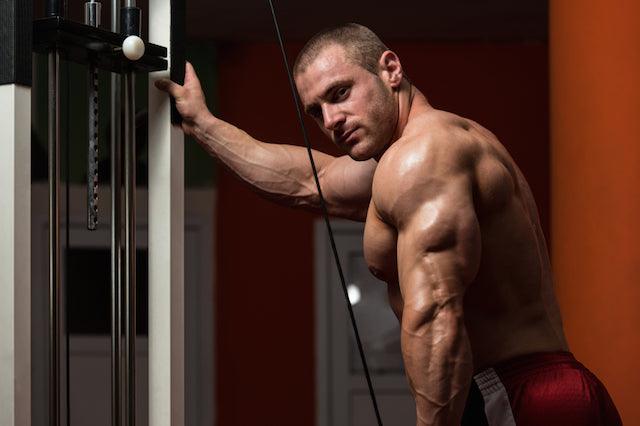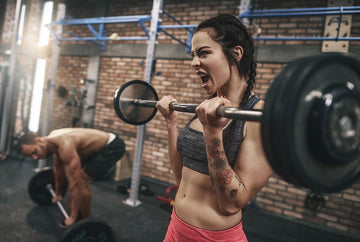

Heavy Weight vs. Metabolic Stress: Which Packs on More Muscle
Table of Contents
Heavy Weight vs. Metabolic Stress: Which Packs on More Muscle
by: Robbie Durand
If you were to pick up any bodybuilding book on the market or fitness magazine, it would probably reference the workout of Arnold Schwarzenegger. Arnold built his physique on high volume exercise, which consisted of moderate weights and lots of repetitions (i.e. 10-12 repetitions) with 3 to 4 sets per exercise. Conversely, high‐intensity, low‐volume programs, powerlifting type protocols (i.e., 3-5 repetitions) utilizing long rest intervals (3-5 minutes) primarily target muscle strength increases. Back in the 90’s, a landmark study by Kraemer found that bodybuilding type protocols with short rest periods and moderate weights resulted in greater increases in GH and testosterone than longer rest period protocols. Everyone thought that greater “metabolic stress” such as resistance exercise protocols that generate a lot of lactic acid and made the muscle “burn” were essential for greater increases in muscle mass. However, others studies have been unable to demonstrate that higher metabolic stress is better for stimulating testosterone and IGF‐1 responses.
Not all bodybuilders train like Arnold, for example, the late Mike Mentzer and Dorian Yates were advocates of heavy weight training with prolonged rest periods, yet they were massive bodybuilders. An alternative theory to high volume training is that high intensity or heavy weight training results in greater mechanical stress (i.e. tension overload) that recruit more fast‐twitch muscle fibers. Using heavier weight can provide a greater stimulus for muscle hypertrophy than the traditional bodybuilding protocol that result in greater metabolic stress.
Heavy Weight vs. Metabolic Stress: Which Packs on More Muscle
A recent study put the heavyweight vs. metabolic stress workout theory to test and examined anabolic hormones and also muscle hypertrophy. Researchers recruited 29 subjects who had been resistance training for a minimum of two years were randomly allocated to either:
– High intensity (low volume) group: Participants performed four sets at 3–5 repetitions with 90% of their 1RM, with 3‐min rest periods between sets, or
-High volume (moderate intensity) group. Participants performed four sets at 10–12 repetitions with 70% of their 1RM, with a 1‐min rest period between sets.
The researchers measured the anabolic hormones: growth hormone, insulin, insulin-like growth factor-1 and testosterone while also measuring strength and hypertrophy. At the end of eight weeks, the key finding were that the heavier weight protocol utilizing longer rest periods stimulated significantly greater 1RM bench press and lean arm mass gains compared to moderate intensity, high-volume bodybuilding type protocol utilizing short rest intervals in resistance-trained men. This goes against the typical theory that bodybuilding protocols that use short rest periods work best for muscle growth.
What’s interesting was the anabolic hormone responses over the eight weeks. Growth hormone and cortisol were greater for the bodybuilding type high volume group. After week 8, both growth hormone and cortisol had plateaued, with the cortisol levels remained significantly higher. This may mean that prolonged high volume training results in a greater potential for overtraining as the bodybuilding type protocol led to higher cortisol responses. Other hormones such as IGF-1, insulin, and testosterone, increased in both groups, but there were no significant differences between the two groups. In the study, the author stated, “the greater mechanical stress imposed by high in was also accompanied by greater gains in lean muscle mass.”
High‐intensity (3–5 RM), low‐volume resistance training program utilizing a long rest interval (3 min) is more advantageous than a moderate intensity, high‐volume (10–12 RM) program using a short rest interval (1 min) for stimulating upper body strength gains and muscle hypertrophy in resistance‐trained men during an 8‐week study. Furthermore, despite the bodybuilding type program resulting in higher GH concentrations, this did not enhance lean muscle mass or strength gains. These observations question the utility of high‐volume training programs that are designed to maximize the acute hormonal response as being ideal for stimulating muscle growth. Emphasizing training intensity over volume may provide an advantage for accelerating muscle growth and strength gains in a short‐term training cycle.
Key Points:
-Heavier weights with longer rest periods resulted in greater lean mass and strength compared to a bodybuilding type protocol with shorter rest periods.
– Despite major increases in GH with the bodybuilding protocol, there were more significant increases in lean mass and strength with the heavier weight protocol.
-After eight weeks of training, the bodybuilding type protocol, cortisol levels remained significantly higher.
Mangine GT, Hoffman JR, Gonzalez AM, Townsend JR, Wells AJ, Jajtner AR, Beyer KS, Boone CH, Miramonti AA, Wang R, LaMonica MB, Fukuda DH, Ratamess NA, Stout JR. The effect of training volume and intensity on improvements in muscular strength and size in resistance-trained men. Physiol Rep. 2015 Aug;3(8). pii:e12472.
Kraemer, W. J., and N. A. Ratamess. 2005. Hormonal responses and adaptations to resistance exercise and training. Sports Med. 35:339–361.
Kraemer, W. J., L. Marchitelli, S. E. Gordon, E. Harman, J. E. Dziados, R. Mello, et al. 1990. Hormonal and growth factor responses to heavy resistance exercise protocols. J. Appl. Physiol. 69:1442–1450.
Schwab, R., G. O. Johnson, T. J. Housh, J. E. Kinder, and J. Weir. 1993. Acute effects of different intensities of weight lifting on serum testosterone. Med. Sci. Sports Exerc. 25:1381–1385.
McCaulley, G. O., J. M. McBride, P. Cormie, M. B. Hudson, J. L. Nuzzo, J. C. Quindry, et al. 2009. Acute hormonal and neuromuscular responses to hypertrophy, strength and power type resistance exercise. Eur. J. Appl. Physiol. 105:695–704.
Clarkson, P. M., K. Nosaka, and B. Braun. 1992. Muscle function after exercise‐induced muscle damage and rapid adaptation. Med. Sci. Sports Exerc. 24:512–520.
Ratamess, N. A., B. A. Alvar, T. K. Evetoch, T. J. Housh, W. B. Kibler, W. J. Kraemer, et al. 2009. American college of sports medicine position stand. Progression models in resistance training for healthy adults. Med. Sci. Sports Exerc. 41:687.
|
MUSCLE MEDIA MAGAZINE NEW ISSUE |

















